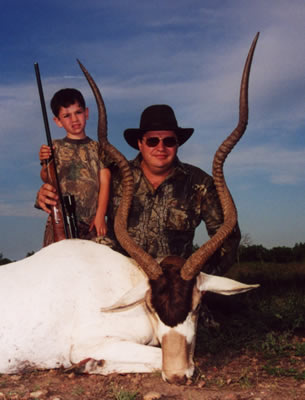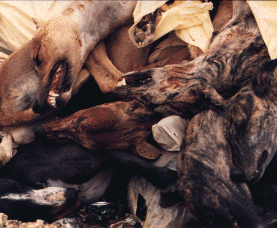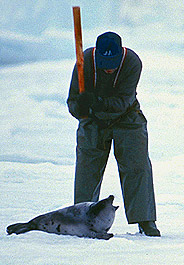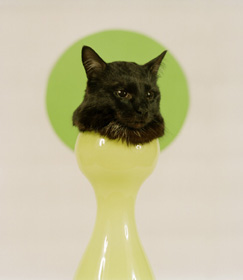|
|
|
 |
Animal Exploitation |  |
|
Defining Exploitation By "exploitation", I am referring to the use of animals as a monetary resource with little or no consideration for their well being. |
|
| Omak Suicide Race (annual event 2nd week of August) Omak, Washington boasts that this is the "deadliest horse race in the world". The Omak Stampede and Suicide Race takes places every year, the second week of August. For four days and nights riders repeatedly send horses off "Suicide Hill" with a 120 foot full gallopping start. Horses then plunge blindly more than 210 feet downhill at slope of approximately 62 degree angle. The horses then meet the rocky Okanogan River an d swim more than a football field in length. The horses then face a grueling uphill sprint. Many of these horses suffer heart attacks, broken bones and drowning. This is no excuse, cultural or otherwise for this kind of animal abuse!! For more information on this cruel event, please click on the picture. |
|
 |
CANNED HUNTS
Canned hunting is the killing of an animal in an enclosure to obtain a trophy. Although canned hunts advertise under a variety of names -- most frequently "hunting preserves," "game ranches," or "shooting preserves" -- they all have in common: they charge their clients a fee to kill an animal. In some cases animals may be shot in cages or within fenced enclosures; in others they may be shot over feeding stations; some of the animals are tame and have little fear of humans, while others may be tied to a stake or drugged before they are shot. A shot to the head might mean a quick kill, but these coward hunters do not do that because that would spoil their trophy, so the shooter (I will not refer to them as hunters because they are not hunters) repeatedly shoots the animals body, sometimes at point blank. The animal will suffer in pain for several minutes before eventually dying. The shooter will never shoot the animal in the shoulder or head, so that it may be preserved as a trophy. After the animal is dead, the shooter will have their picture taken with their kill, usually posing as though they were on a big game African Safari (yeah....right!). It happens much like ordering off of a menu - maybe a wolf for , a bear for and a tiger for . There are many animals that have been auctioned off and sold to "big game" ranches because they were bred for it or abandoned by owners who didn't understand the responsibilities of caring for an exotic animal. Many zoos sell their "surplus" animals either directly to canned hunting preserves or to middlemen and dealers who later sell to the hunts. Because baby animals are popular, zoos continue to breed their animals. But space is limited, and for every baby born an adult animal must leave. |
 |
SLAUGHTERED RETIRED RACE HORSES Horses end up in slaughter in a variety of ways, all unlucky. Sometimes they are sent to slaughter by individuals or groups no longer able or willing to care for them. Sometimes they are retired or injured race horses, riding school or show horses, federally protected wild horses, foals born as a by-product of the Premarin industry, or stolen horses. Auction houses provide an easy out for irresponsible equine owners to discard an animal they no longer want while getting some cash in return. Those purchased at auctions by individuals known as "killer buyers" are then shipped on double-deck trailers for as long as several days without adequate water, food, or rest only to arrive at the slaughterhouse where workers abuse them right up to the actual slaughter. According to the US Department of Agriculture, 42,312 horses were slaughtered in 2002. In addition to the horses killed in the two US-based plants, thousands more are transported under deplorable conditions across our borders into Canada and Mexico to be slaughtered. Horses are often transported for more than 24 hours without rest, water, or food, while unprotected from weather extremes in thin metal-walled trailers. Sick and/or injured horses frequently are forced onto double-deck trailers that were designed for short-necked animals including cattle and sheep. |
 |
SLAUGHTER OF RACING GREYHOUNDS In the United States and Mexico dog racing has become extremely popular. The fastest runner among the canines is the Greyhound breed. Millions of dollars are wagered on Greyhound races every single year. Greyhound racing is the sixth most attended sporting event in the USA. The Greyhound Racing Industry has tried hard over the years to convince the public that dogs no longer deemed useful to their owners are found caring homes and thus live out their remaining years in adopted bliss. This is a flat-out lie! The Humane Society estimates up to 50,000 dogs are put down annually because they can no longer compete on America's dogtracks. Only a small percentage are euthanized by veterinarians. The rest are shot and dumped in landfills, abandoned along the highways, left in their cages to starve, blugeoned or hanged. And because greyhounds are known to endure overwhelming abuse without any lasting effect on their personalities, some are sold illegally for research, including bone-breaking experiments. In most cases, the dogs' ears are sliced off to prevent identification. researchers love Greyhounds because they're calm, they're tractable, they don't bark, and they have a high level of pain tolerance. They have no hair, no fat. They have a universal blood type, a large heart, and a magnificent skeletal system. |
 |
The Slaughtering of Harp Seal Pups Seal hunters called "beaters"—kill seal pups who are at least two weeks old. And once a baby seal starts to molt even a part of its white coat, the Canadian government allows hunters to beat the pups to death with a club or a large ice-pick-like hakapik. There have even been reports of sealers killing mothers who try to protect their unweaned pups. Under the government's latest plan, hunters will be allowed to kill 975,000 harp seals on their home ice east of Newfoundland and Labrador during a three-year period. We don't know how many more seals were killed than were reported, but we do know that in the 2001-2002 hunt, sealers killed at least 30,000 more seals than allowed by law. And how did the Canadian government punish the sealers? By upping the quota. The Canadian givernment has proven that is is more interested in promoting a commercial seal hunt than the humane treatment of seals. Evidence showed that nearly 40% of seal pups were being skinned while still alive and conscious. |
 |
Animals In Art Take a good look at this picture. This is not clever photo editing, this is someone killing animals in the name of 'art'. Nathalia Edenmont is an artist who uses dead animals in her works. She kills these cats, rabbits and mice herself, 15 minutes before taking the photographs . Nathalia grew up in the former Soviet Union, and claims that she killed and decapitated the animals herself, and there is no evidence to suggest otherwise. The Wetterling Gallery has encouraged Edenmont to use larger animals in the future. There is a clear history of mental instability in the arts. Van Gough cut off his own ear, and Dali threw cats into a swimming pool, but the art world should not encourage destructive behavior. It is time for galleries, art critics and art publications to accept responsibility for the actions of artists and to refuse to celebrate abuse, cruelty and killing as art. *Note: Wetterling Gallery in Sweden exhibits her art, as well as Chisenhale Gallery in London. |
|
|
|